University Nursing Report: Reflecting on a Patient Safety Incident
VerifiedAdded on 2022/08/26
|6
|1288
|21
Report
AI Summary
This report presents a critical reflection on a nursing student's experience involving a medication error during a clinical placement. The student, a new graduate nurse, describes an incident where a medication was administered incorrectly, leading to a patient safety concern. The reflection utilizes Gibbs' reflective cycle to analyze the experience, exploring the description of the incident, the student's feelings and thoughts at the time, an evaluation of what went well and what could have been improved, an analysis of the situation considering relevant literature and the NSQHS standards, conclusions drawn from the experience, and an action plan for future practice. The student highlights the impact of stress, anxiety, and a lack of clinical reasoning skills on the incident, emphasizing the importance of cultural competence, double-checking medications, and adherence to evidence-based practice guidelines. The report underscores the value of peer support, critical thinking, and the use of electronic medical records in ensuring patient safety, and includes references to relevant literature supporting the analysis and recommendations.
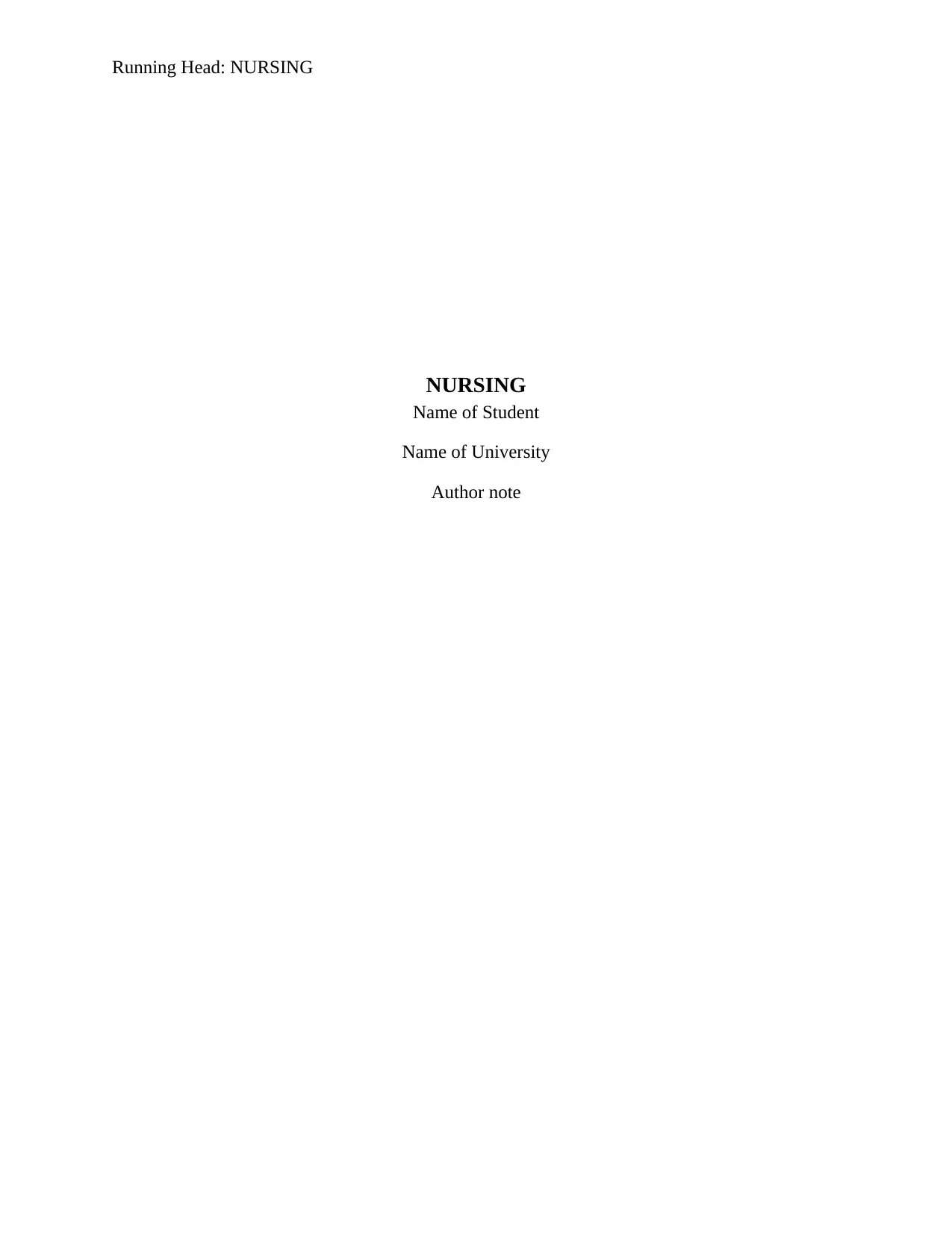
Running Head: NURSING
NURSING
Name of Student
Name of University
Author note
NURSING
Name of Student
Name of University
Author note
Paraphrase This Document
Need a fresh take? Get an instant paraphrase of this document with our AI Paraphraser
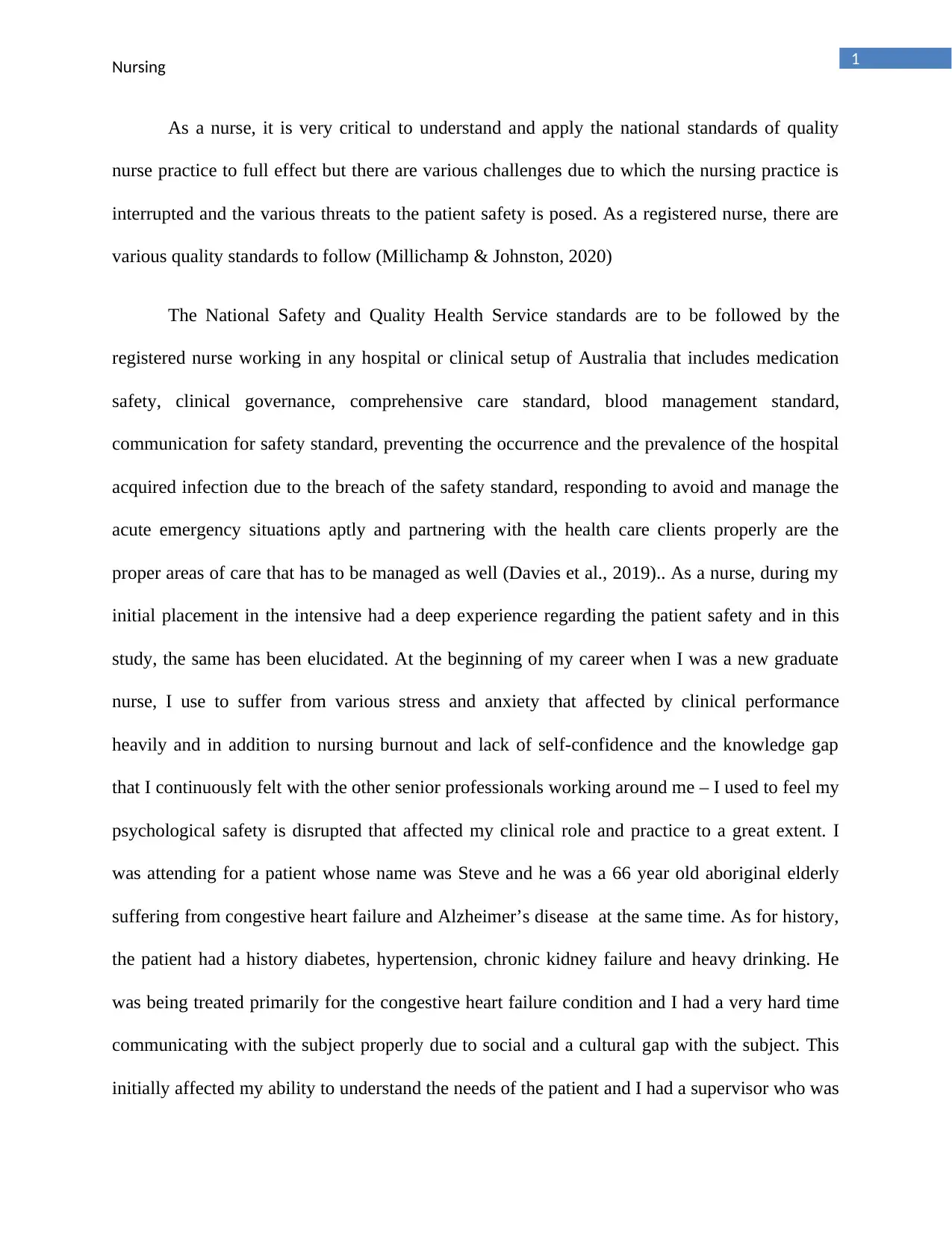
1Nursing
As a nurse, it is very critical to understand and apply the national standards of quality
nurse practice to full effect but there are various challenges due to which the nursing practice is
interrupted and the various threats to the patient safety is posed. As a registered nurse, there are
various quality standards to follow (Millichamp & Johnston, 2020)
The National Safety and Quality Health Service standards are to be followed by the
registered nurse working in any hospital or clinical setup of Australia that includes medication
safety, clinical governance, comprehensive care standard, blood management standard,
communication for safety standard, preventing the occurrence and the prevalence of the hospital
acquired infection due to the breach of the safety standard, responding to avoid and manage the
acute emergency situations aptly and partnering with the health care clients properly are the
proper areas of care that has to be managed as well (Davies et al., 2019).. As a nurse, during my
initial placement in the intensive had a deep experience regarding the patient safety and in this
study, the same has been elucidated. At the beginning of my career when I was a new graduate
nurse, I use to suffer from various stress and anxiety that affected by clinical performance
heavily and in addition to nursing burnout and lack of self-confidence and the knowledge gap
that I continuously felt with the other senior professionals working around me – I used to feel my
psychological safety is disrupted that affected my clinical role and practice to a great extent. I
was attending for a patient whose name was Steve and he was a 66 year old aboriginal elderly
suffering from congestive heart failure and Alzheimer’s disease at the same time. As for history,
the patient had a history diabetes, hypertension, chronic kidney failure and heavy drinking. He
was being treated primarily for the congestive heart failure condition and I had a very hard time
communicating with the subject properly due to social and a cultural gap with the subject. This
initially affected my ability to understand the needs of the patient and I had a supervisor who was
As a nurse, it is very critical to understand and apply the national standards of quality
nurse practice to full effect but there are various challenges due to which the nursing practice is
interrupted and the various threats to the patient safety is posed. As a registered nurse, there are
various quality standards to follow (Millichamp & Johnston, 2020)
The National Safety and Quality Health Service standards are to be followed by the
registered nurse working in any hospital or clinical setup of Australia that includes medication
safety, clinical governance, comprehensive care standard, blood management standard,
communication for safety standard, preventing the occurrence and the prevalence of the hospital
acquired infection due to the breach of the safety standard, responding to avoid and manage the
acute emergency situations aptly and partnering with the health care clients properly are the
proper areas of care that has to be managed as well (Davies et al., 2019).. As a nurse, during my
initial placement in the intensive had a deep experience regarding the patient safety and in this
study, the same has been elucidated. At the beginning of my career when I was a new graduate
nurse, I use to suffer from various stress and anxiety that affected by clinical performance
heavily and in addition to nursing burnout and lack of self-confidence and the knowledge gap
that I continuously felt with the other senior professionals working around me – I used to feel my
psychological safety is disrupted that affected my clinical role and practice to a great extent. I
was attending for a patient whose name was Steve and he was a 66 year old aboriginal elderly
suffering from congestive heart failure and Alzheimer’s disease at the same time. As for history,
the patient had a history diabetes, hypertension, chronic kidney failure and heavy drinking. He
was being treated primarily for the congestive heart failure condition and I had a very hard time
communicating with the subject properly due to social and a cultural gap with the subject. This
initially affected my ability to understand the needs of the patient and I had a supervisor who was
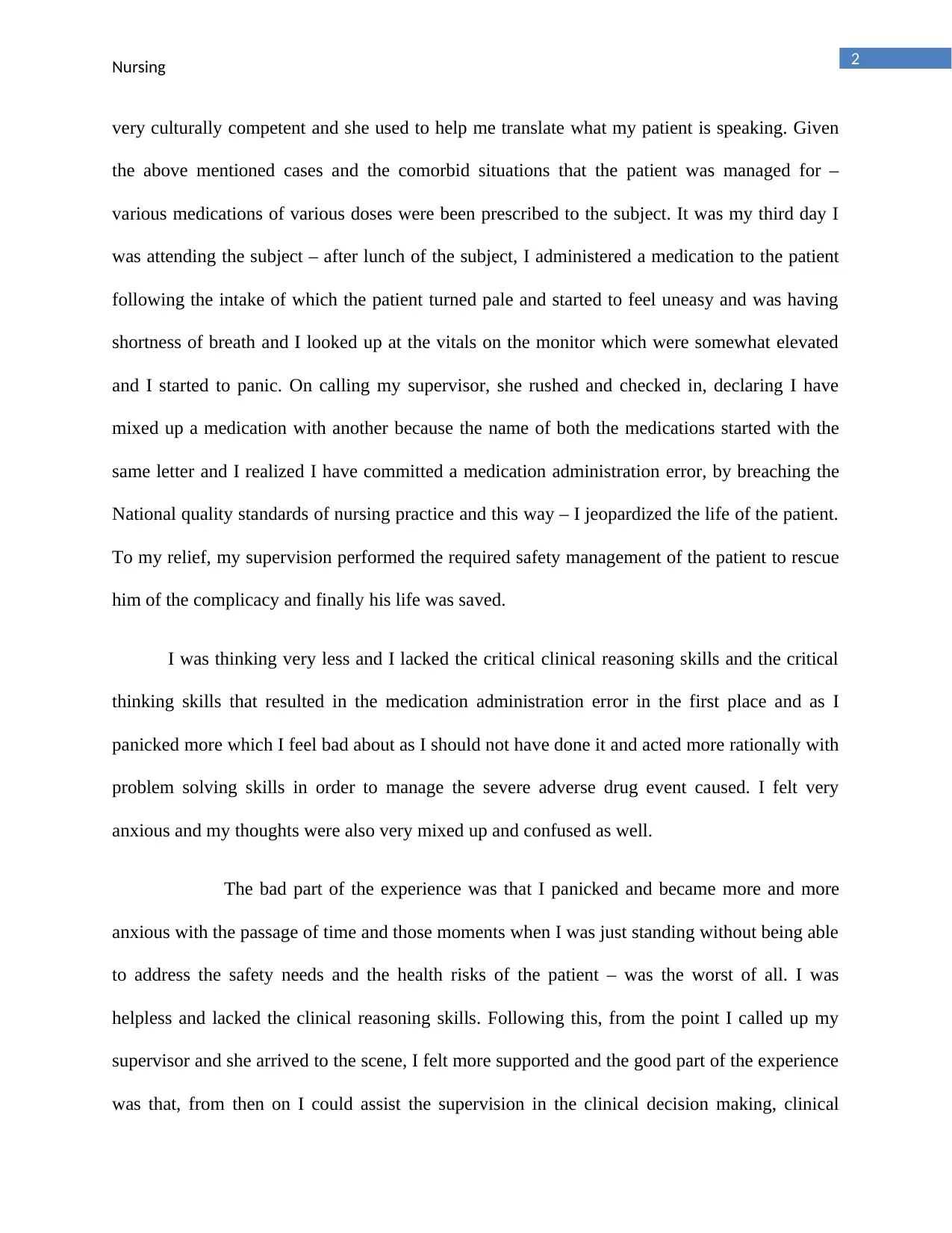
2Nursing
very culturally competent and she used to help me translate what my patient is speaking. Given
the above mentioned cases and the comorbid situations that the patient was managed for –
various medications of various doses were been prescribed to the subject. It was my third day I
was attending the subject – after lunch of the subject, I administered a medication to the patient
following the intake of which the patient turned pale and started to feel uneasy and was having
shortness of breath and I looked up at the vitals on the monitor which were somewhat elevated
and I started to panic. On calling my supervisor, she rushed and checked in, declaring I have
mixed up a medication with another because the name of both the medications started with the
same letter and I realized I have committed a medication administration error, by breaching the
National quality standards of nursing practice and this way – I jeopardized the life of the patient.
To my relief, my supervision performed the required safety management of the patient to rescue
him of the complicacy and finally his life was saved.
I was thinking very less and I lacked the critical clinical reasoning skills and the critical
thinking skills that resulted in the medication administration error in the first place and as I
panicked more which I feel bad about as I should not have done it and acted more rationally with
problem solving skills in order to manage the severe adverse drug event caused. I felt very
anxious and my thoughts were also very mixed up and confused as well.
The bad part of the experience was that I panicked and became more and more
anxious with the passage of time and those moments when I was just standing without being able
to address the safety needs and the health risks of the patient – was the worst of all. I was
helpless and lacked the clinical reasoning skills. Following this, from the point I called up my
supervisor and she arrived to the scene, I felt more supported and the good part of the experience
was that, from then on I could assist the supervision in the clinical decision making, clinical
very culturally competent and she used to help me translate what my patient is speaking. Given
the above mentioned cases and the comorbid situations that the patient was managed for –
various medications of various doses were been prescribed to the subject. It was my third day I
was attending the subject – after lunch of the subject, I administered a medication to the patient
following the intake of which the patient turned pale and started to feel uneasy and was having
shortness of breath and I looked up at the vitals on the monitor which were somewhat elevated
and I started to panic. On calling my supervisor, she rushed and checked in, declaring I have
mixed up a medication with another because the name of both the medications started with the
same letter and I realized I have committed a medication administration error, by breaching the
National quality standards of nursing practice and this way – I jeopardized the life of the patient.
To my relief, my supervision performed the required safety management of the patient to rescue
him of the complicacy and finally his life was saved.
I was thinking very less and I lacked the critical clinical reasoning skills and the critical
thinking skills that resulted in the medication administration error in the first place and as I
panicked more which I feel bad about as I should not have done it and acted more rationally with
problem solving skills in order to manage the severe adverse drug event caused. I felt very
anxious and my thoughts were also very mixed up and confused as well.
The bad part of the experience was that I panicked and became more and more
anxious with the passage of time and those moments when I was just standing without being able
to address the safety needs and the health risks of the patient – was the worst of all. I was
helpless and lacked the clinical reasoning skills. Following this, from the point I called up my
supervisor and she arrived to the scene, I felt more supported and the good part of the experience
was that, from then on I could assist the supervision in the clinical decision making, clinical
⊘ This is a preview!⊘
Do you want full access?
Subscribe today to unlock all pages.

Trusted by 1+ million students worldwide
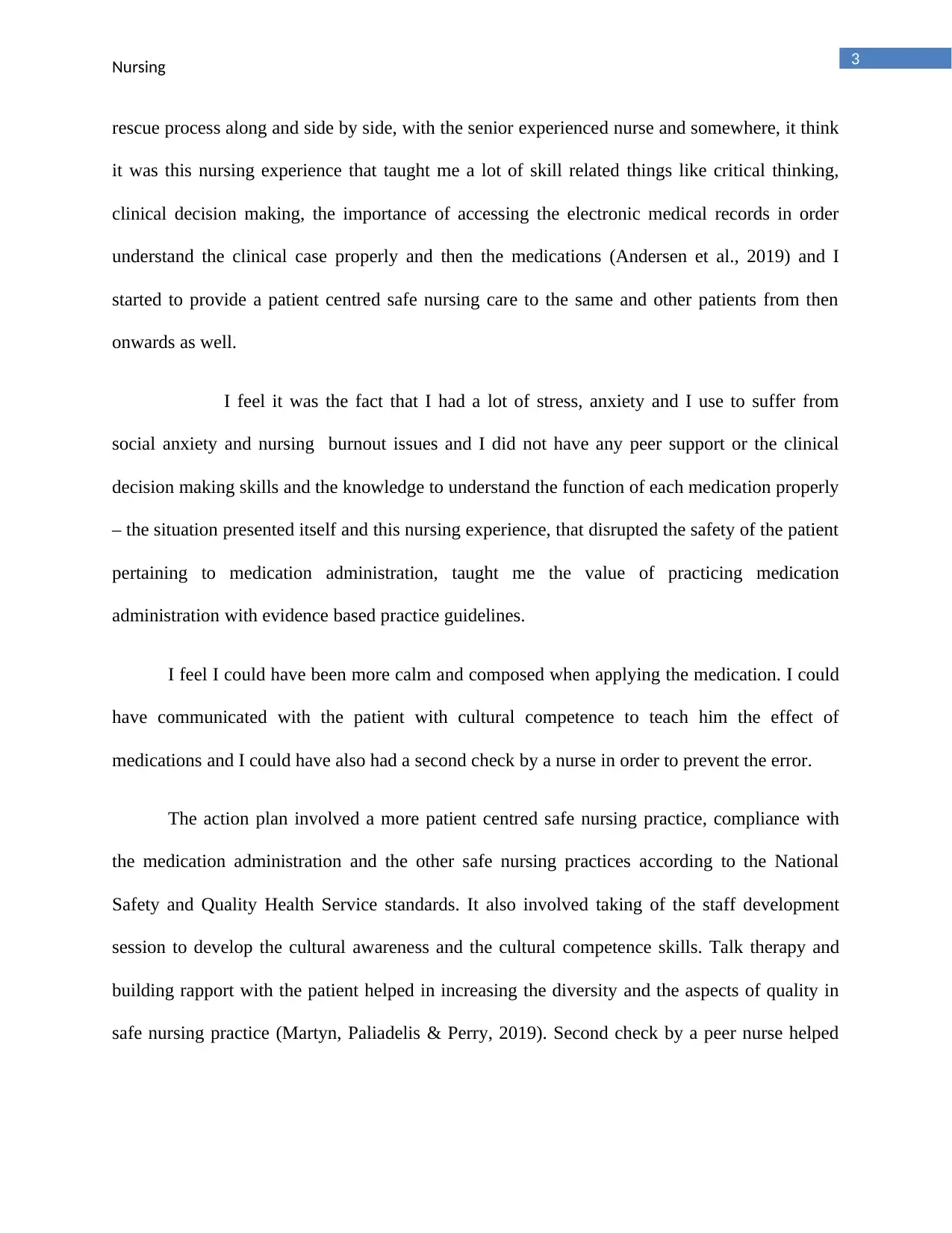
3Nursing
rescue process along and side by side, with the senior experienced nurse and somewhere, it think
it was this nursing experience that taught me a lot of skill related things like critical thinking,
clinical decision making, the importance of accessing the electronic medical records in order
understand the clinical case properly and then the medications (Andersen et al., 2019) and I
started to provide a patient centred safe nursing care to the same and other patients from then
onwards as well.
I feel it was the fact that I had a lot of stress, anxiety and I use to suffer from
social anxiety and nursing burnout issues and I did not have any peer support or the clinical
decision making skills and the knowledge to understand the function of each medication properly
– the situation presented itself and this nursing experience, that disrupted the safety of the patient
pertaining to medication administration, taught me the value of practicing medication
administration with evidence based practice guidelines.
I feel I could have been more calm and composed when applying the medication. I could
have communicated with the patient with cultural competence to teach him the effect of
medications and I could have also had a second check by a nurse in order to prevent the error.
The action plan involved a more patient centred safe nursing practice, compliance with
the medication administration and the other safe nursing practices according to the National
Safety and Quality Health Service standards. It also involved taking of the staff development
session to develop the cultural awareness and the cultural competence skills. Talk therapy and
building rapport with the patient helped in increasing the diversity and the aspects of quality in
safe nursing practice (Martyn, Paliadelis & Perry, 2019). Second check by a peer nurse helped
rescue process along and side by side, with the senior experienced nurse and somewhere, it think
it was this nursing experience that taught me a lot of skill related things like critical thinking,
clinical decision making, the importance of accessing the electronic medical records in order
understand the clinical case properly and then the medications (Andersen et al., 2019) and I
started to provide a patient centred safe nursing care to the same and other patients from then
onwards as well.
I feel it was the fact that I had a lot of stress, anxiety and I use to suffer from
social anxiety and nursing burnout issues and I did not have any peer support or the clinical
decision making skills and the knowledge to understand the function of each medication properly
– the situation presented itself and this nursing experience, that disrupted the safety of the patient
pertaining to medication administration, taught me the value of practicing medication
administration with evidence based practice guidelines.
I feel I could have been more calm and composed when applying the medication. I could
have communicated with the patient with cultural competence to teach him the effect of
medications and I could have also had a second check by a nurse in order to prevent the error.
The action plan involved a more patient centred safe nursing practice, compliance with
the medication administration and the other safe nursing practices according to the National
Safety and Quality Health Service standards. It also involved taking of the staff development
session to develop the cultural awareness and the cultural competence skills. Talk therapy and
building rapport with the patient helped in increasing the diversity and the aspects of quality in
safe nursing practice (Martyn, Paliadelis & Perry, 2019). Second check by a peer nurse helped
Paraphrase This Document
Need a fresh take? Get an instant paraphrase of this document with our AI Paraphraser
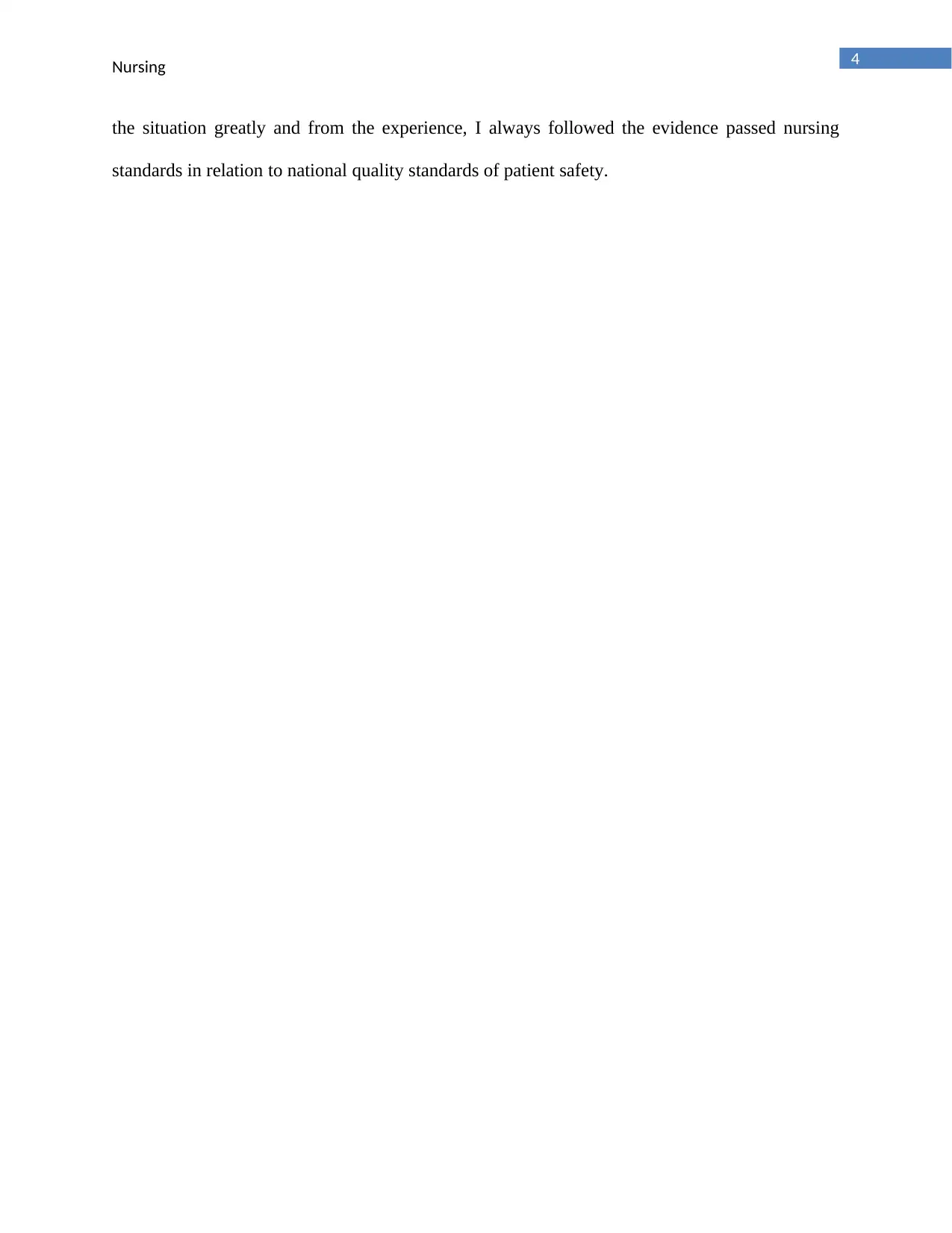
4Nursing
the situation greatly and from the experience, I always followed the evidence passed nursing
standards in relation to national quality standards of patient safety.
the situation greatly and from the experience, I always followed the evidence passed nursing
standards in relation to national quality standards of patient safety.
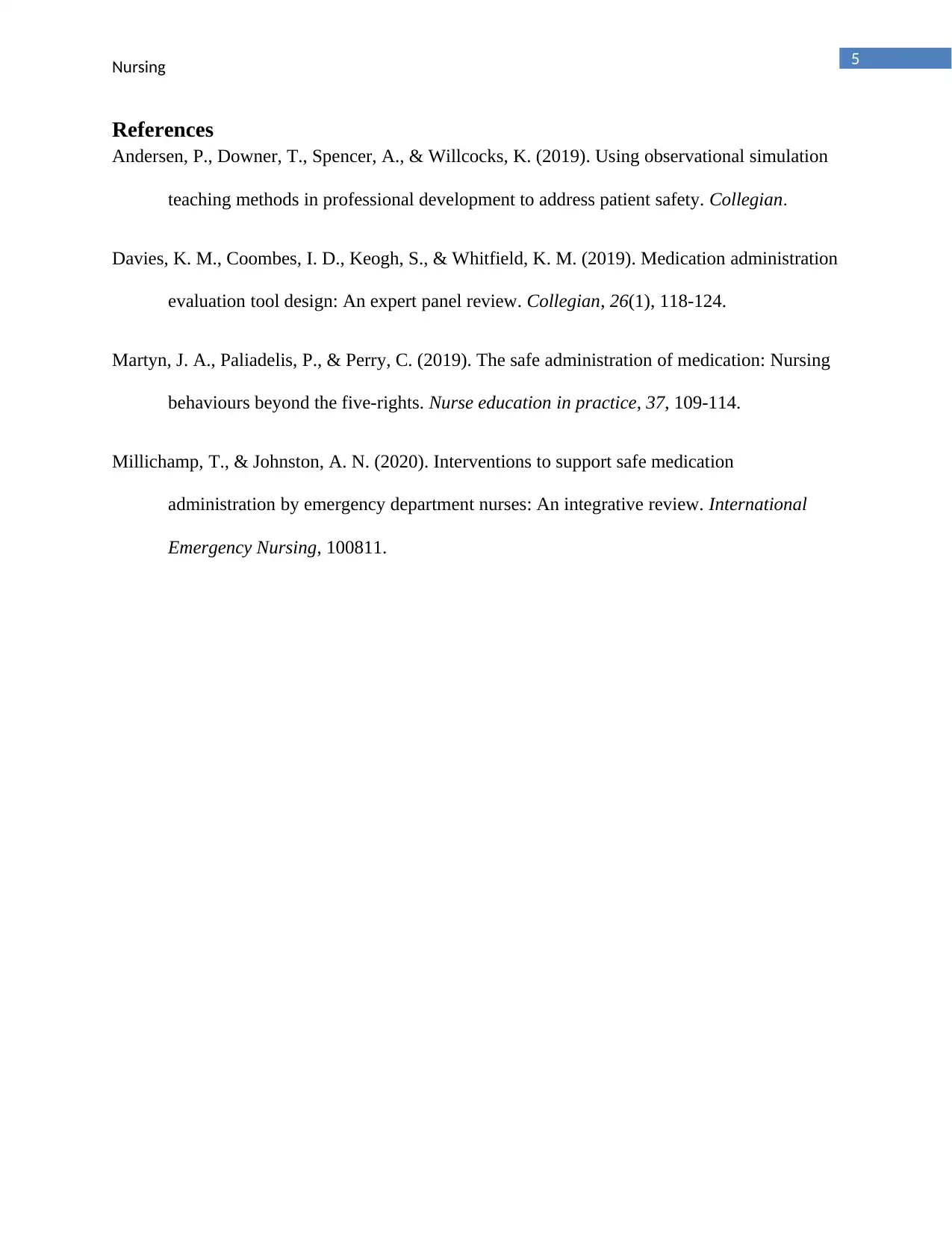
5Nursing
References
Andersen, P., Downer, T., Spencer, A., & Willcocks, K. (2019). Using observational simulation
teaching methods in professional development to address patient safety. Collegian.
Davies, K. M., Coombes, I. D., Keogh, S., & Whitfield, K. M. (2019). Medication administration
evaluation tool design: An expert panel review. Collegian, 26(1), 118-124.
Martyn, J. A., Paliadelis, P., & Perry, C. (2019). The safe administration of medication: Nursing
behaviours beyond the five-rights. Nurse education in practice, 37, 109-114.
Millichamp, T., & Johnston, A. N. (2020). Interventions to support safe medication
administration by emergency department nurses: An integrative review. International
Emergency Nursing, 100811.
References
Andersen, P., Downer, T., Spencer, A., & Willcocks, K. (2019). Using observational simulation
teaching methods in professional development to address patient safety. Collegian.
Davies, K. M., Coombes, I. D., Keogh, S., & Whitfield, K. M. (2019). Medication administration
evaluation tool design: An expert panel review. Collegian, 26(1), 118-124.
Martyn, J. A., Paliadelis, P., & Perry, C. (2019). The safe administration of medication: Nursing
behaviours beyond the five-rights. Nurse education in practice, 37, 109-114.
Millichamp, T., & Johnston, A. N. (2020). Interventions to support safe medication
administration by emergency department nurses: An integrative review. International
Emergency Nursing, 100811.
⊘ This is a preview!⊘
Do you want full access?
Subscribe today to unlock all pages.

Trusted by 1+ million students worldwide
1 out of 6
Related Documents
Your All-in-One AI-Powered Toolkit for Academic Success.
+13062052269
info@desklib.com
Available 24*7 on WhatsApp / Email
![[object Object]](/_next/static/media/star-bottom.7253800d.svg)
Unlock your academic potential
Copyright © 2020–2025 A2Z Services. All Rights Reserved. Developed and managed by ZUCOL.





